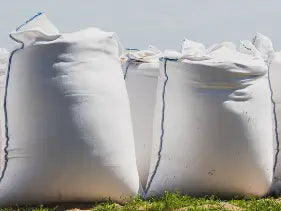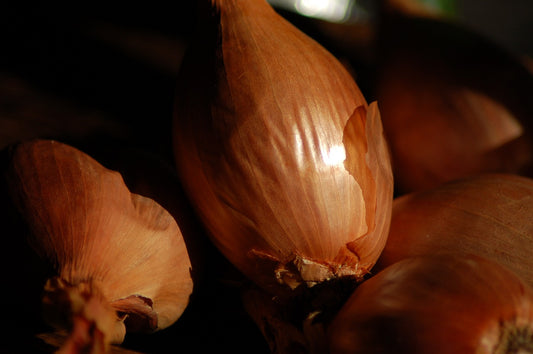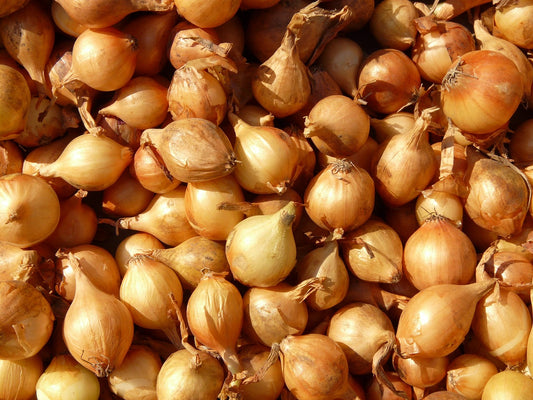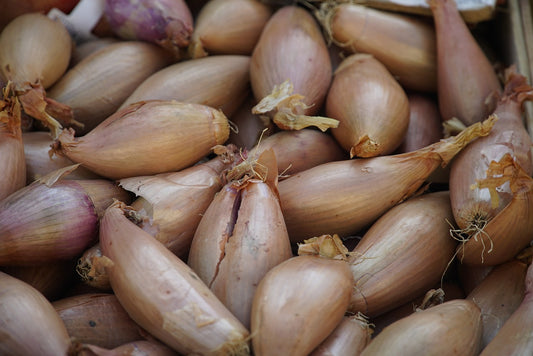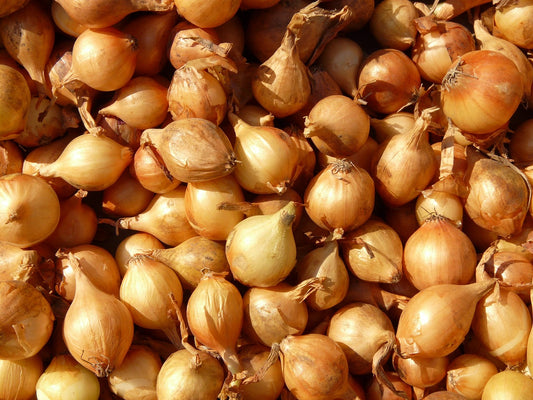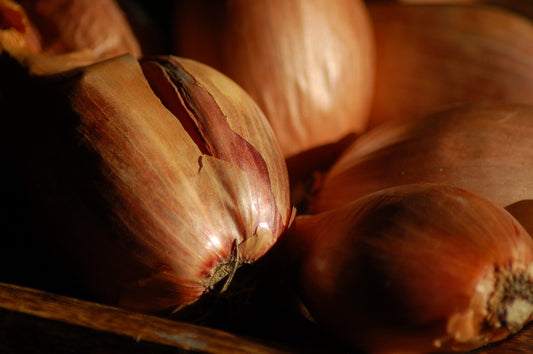-
Delivery from 1 bag of 5kg France, Switzerland and Europe
Delivery Terms -
Online Vegetable Bulb Wholesaler - Producer Prices
About Us -
Quality Bulbs
Our Culture Guide -
Secure payment
Our Payment Terms
Our quality organic shallot bulbs and bulbils for professional market gardeners
Buy now and get it delivered when you're ready to plant
-
Big Bag 1 Ton of Biztro 14/21 Organic Shallot Bulbils
Regular price €3,70Regular priceUnit price €3.700,00 / per 1000kg -
Big Bag 1 Ton of Bulbils Shallot Red Sun 14/21 Organic
Regular price €3,89Regular priceUnit price / per -
Organic Longor Shallot Bulbs - Size 10/21 - 25kg Bag
Regular price €5,46Regular priceUnit price €136,50 / per 25kg -
Organic Red Sun Shallot Bulbs - Size 10/21 - 25kg Bag
Regular price €4,35Regular priceUnit price €108,75 / per 25kg -
Biztro Organic Shallot Bulbs - Size 10/21 - 25Kg Bag
Regular price €4,35Regular priceUnit price €108,75 / per 25kg
Collapsible content
How to Choose Your Variety of Garlic, Onion or Shallot?
Choosing the right garlic, onion, and shallot bulb varieties is a crucial step in any vegetable production. This choice can mean the difference between a bountiful harvest and a mediocre yield. It's therefore essential to carefully consider two factors: the type of soil in which you'll be planting your bulbs and your customers' preferences. In this article, we'll explore how to make the right choices to optimize your crops and meet your buyers' expectations.
Our Guides to Choosing Your Variety by Species:
Garlic Guide - How to choose your variety?
Onion Guide - How to Choose Your Variety?
Shallot Guide - How to Choose Your Shallot Variety?
Why is variety selection crucial for your crop?
Every soil is unique, and not all garlic, onion, and shallot bulb varieties respond the same way to different soils. Additionally, your customers may have specific preferences regarding the size, color, taste, and even shelf life of the products you offer. If you don't tailor your variety choices to these two criteria, you risk affecting both your yield and your relationship with your customers.
To begin, it's important to understand that soil and climate conditions play a major role in the growth of these bulbs. Soils that are too heavy or poorly drained can be disastrous for some varieties, while others thrive. Furthermore, your customers, whether end consumers or distributors, expect specific quality, which can be influenced by the choice of variety.
Know your soil before choosing your bulbs
Your soil's properties should be one of the first things to evaluate before choosing your garlic, onion, and shallot bulbs. Some soils retain more moisture than others, some are more acidic, and still others may be more compact. Here's how these characteristics affect your plantings:
Clay and heavy soils:
These soils tend to retain a lot of water, which can lead to bulb rot if irrigation is not well controlled. For heavy soils, it is best to choose varieties that are resistant to excessive moisture. For example, some hard garlic varieties (rigid-stemmed garlic) tolerate wet conditions better than soft garlic varieties.
Sandy and light soils:
These well-drained soils are best suited for bulb crops, especially garlic and onions. However, they require more frequent addition of organic matter to maintain soil structure and fertility. Red onion varieties, often popular with consumers, thrive in these lighter soils.
Limestone soils:
Limestone-rich soils are often ideal for bulbs, as they provide good drainage while retaining sufficient nutrients. Shallots, in particular, prefer these conditions. If you're working in this type of soil, it's recommended to choose specific shallot varieties such as the gray shallot, which develops more pronounced flavors.
Meeting your customers’ expectations: another essential factor
The choice of varieties must also take into account the needs and expectations of your customers. Whether they are wholesalers, resellers, or end consumers, they are looking for products that meet specific criteria. As a market gardener, you must be able to adapt to these requirements to build customer loyalty and ensure good sales of your products.
Bulb size and appearance:
Some customers seek larger bulbs for aesthetic or practical reasons. For example, chefs may prefer larger onions for easier cutting. If you're selling to restaurants, it may be a good idea to choose yellow or white onion varieties that offer larger sizes.
Taste and conservation:
Taste is another differentiating factor. Purple or pink garlic varieties are highly valued for their more pronounced flavor, while other varieties are milder and store better. If your customers prefer long-lasting bulbs, you'll need to select varieties that are suitable for this, such as white garlic, which can easily be stored for up to 8 months.
Organic or conventional cultivation methods:
More and more consumers are interested in the origin of their food, and this includes the growing method. Some customers may prefer organically grown bulbs, while others are more focused on price. Therefore, it's essential to offer varieties that are suitable for both growing methods.
What are the differentiating elements of Bulbiverse?
If you're looking for a quality bulb supplier, Bulbiverse stands out for several key features. These include:
- Professional quality garlic, onion, and shallot bulbs and bulbils : To ensure successful harvests, it is essential to start with quality equipment.
- Delivery throughout France : No matter where you are located, you can receive your order quickly and without complications.
- Competitive producer price : With decreasing prices based on volume, you can optimize your purchasing costs.
These elements allow Bulbiverse to offer a service that is both practical and competitive, adapted to the needs of both producers and resellers.
How to choose the right supplier for your bulbs?
Choosing the right supplier can also impact the success of your plantations. A reliable supplier must not only offer quality products, but also provide technical support and advice tailored to your needs. With Bulbiverse, you benefit from a responsive service, capable of providing quotes within 48 hours and personalized technical advice to optimize your production.
Tips for choosing your supplier:
- Check the product range: Does the supplier offer a wide variety of bulbs, including organic ones?
- Is the delivery service reliable and suitable for your needs?
- Is the price competitive with the market?
FAQs
- What types of soil are best for garlic, onion, and shallot bulbs? Well-drained soils rich in organic matter, such as sandy or chalky soils, are best. Soils that are too clayey can cause bulb rot.
- How do I choose the right garlic varieties for my customers? Choose varieties based on their taste (hot or mild) and shelf life. For example, white garlic has a longer shelf life than purple garlic.
- Which onion varieties grow best in heavy soils? White or yellow onions, like long-stemmed varieties, are often more tolerant of heavy soils than red onions.
- What are the benefits of working with Bulbiverse? Bulbiverse offers professional-quality bulbs, delivered throughout France, with competitive prices and responsive customer service.
- Are shallots more sensitive to certain soil types? Yes, shallots generally prefer well-drained, lime-rich soils. They can be sensitive to excess moisture.
- How does Bulbiverse guarantee bulb quality? Bulbiverse carefully selects its varieties and offers fast delivery to ensure freshness and quality.
Conclusion
In conclusion, choosing the right garlic, onion, and shallot bulb varieties is a crucial step in ensuring the success of your crop and satisfying your customers. By considering your soil characteristics and market expectations, you will optimize both your yields and customer satisfaction. Partnering with a reliable supplier like Bulbiverse will ensure a quality supply and optimal customer service to ensure your crop success.
When to plant? When to harvest?
Do you want to start growing garlic, onions, or shallots but don't know when to reserve your plants, when to plant them, or even when to harvest them?
On this page you will find the growing steps for each variety of garlic, onion, and shallot. When to plant and when to harvest?
Summary
- Onion Planting and Harvesting Calendar
- Shallots Planting and Harvesting Calendar
- Garlic Planting and Harvesting Calendar
Onion Planting and Harvesting Calendar
| Onion | Jan | Feb | Mar | Apr | May | Jul | Jul | Aug | Sep | Oct | Nov | Dec | |||||||||||||
|---|---|---|---|---|---|---|---|---|---|---|---|---|---|---|---|---|---|---|---|---|---|---|---|---|---|
| Sturon Onion | Planting | ||||||||||||||||||||||||
| Harvest | |||||||||||||||||||||||||
| Straw of Virtues Onion | Planting | ||||||||||||||||||||||||
| Harvest | |||||||||||||||||||||||||
| Stuttgarter Riesen F1 | Planting | ||||||||||||||||||||||||
| Harvest | |||||||||||||||||||||||||
| Hercules Onion | Planting | ||||||||||||||||||||||||
| Harvest | |||||||||||||||||||||||||
| Shakespeare Onion | Planting | ||||||||||||||||||||||||
| Harvest | |||||||||||||||||||||||||
| Crusado Onion F1 | Planting | ||||||||||||||||||||||||
| Harvest | |||||||||||||||||||||||||
| Setton Onion | Planting | ||||||||||||||||||||||||
| Harvest | |||||||||||||||||||||||||
| Senshyu Yellow Onion | Planting | ||||||||||||||||||||||||
| Harvest | |||||||||||||||||||||||||
| Contado F1 Onion | Planting | ||||||||||||||||||||||||
| Harvest | |||||||||||||||||||||||||
| Corrado F1 Onion | Planting | ||||||||||||||||||||||||
| Harvest | |||||||||||||||||||||||||
| Cupido F1 Onion | Planting | ||||||||||||||||||||||||
| Harvest | |||||||||||||||||||||||||
| Birnformige Onion | Planting | ||||||||||||||||||||||||
| Harvest | |||||||||||||||||||||||||
| Snowball Onion | Planting | ||||||||||||||||||||||||
| Harvest | |||||||||||||||||||||||||
| Red Radiant Onion | Planting | ||||||||||||||||||||||||
| Harvest | |||||||||||||||||||||||||
| Romy Onion | Planting | ||||||||||||||||||||||||
| Harvest | |||||||||||||||||||||||||
| Red Karmen Onion | Planting | ||||||||||||||||||||||||
| Harvest | |||||||||||||||||||||||||
| Red Baron Onion | Planting | ||||||||||||||||||||||||
| Harvest | |||||||||||||||||||||||||
| Rosanna Onion | Planting | ||||||||||||||||||||||||
| Harvest | |||||||||||||||||||||||||
| Ptujski Rdeca Onion | Planting | ||||||||||||||||||||||||
| Harvest | |||||||||||||||||||||||||
In summary:
- Sturon onion : Plant in March-April, harvest in August-September.
- Paille des Vertus Onion : Plant in March-April, harvest in August-September.
- Stuttgarter Riesen F1 onion : Plant in March-April, harvest in August-September.
- Hercules onion : Plant in March-April, harvest in August-September.
- Shakespeare Onion : Plant in March-April, harvest in August-September.
- Crusado F1 Onion : Plant in March-April, harvest in August-September.
- Setton onion : Plant in March-April, harvest in August-September.
- Senshyu Yellow Onion : Plant in March-April, harvest in August-September.
- Contado F1 Onion : Plant in March-April, harvest in August-September.
- Corrado F1 Onion : Plant in March-April, harvest in August-September.
- Cupido F1 Onion : Plant in March-April, harvest in August-September.
- Birnformige onion : Plant in March-April, harvest in August-September.
- Snowball Onion : Plant in March-April, harvest in August-September.
- Red Radiant Onion : Plant in March-April, harvest in August-September.
- Romy onion : Plant in March-April, harvest in August-September.
- Red Karmen Onion : Plant in March-April, harvest in August-September.
- Red Baron Onion : Plant in March-April, harvest in August-September.
- Rosanna onion : Plant in March-April, harvest in August-September.
- Ptujski Rdeca onion : Planting in March-April, harvesting in August-September.
Shallots Planting and Harvesting Calendar
| Shallot | Jan | Feb | Mar | Apr | May | Jul | Jul | Aug | Sep | Oct | Nov | Dec | |||||||||||||
|---|---|---|---|---|---|---|---|---|---|---|---|---|---|---|---|---|---|---|---|---|---|---|---|---|---|
| Longor shallot | Planting | ||||||||||||||||||||||||
| Harvest | |||||||||||||||||||||||||
| Mikor Shallot | Planting | ||||||||||||||||||||||||
| Harvest | |||||||||||||||||||||||||
| Jermor Shallot | Planting | ||||||||||||||||||||||||
| Harvest | |||||||||||||||||||||||||
| Red Sun Shallot | Planting | ||||||||||||||||||||||||
| Harvest | |||||||||||||||||||||||||
| Biztro Shallot | Planting | ||||||||||||||||||||||||
| Harvest | |||||||||||||||||||||||||
| Melkior Shallot | Planting | ||||||||||||||||||||||||
| Harvest | |||||||||||||||||||||||||
| Golden Gourmet Shallot | Planting | ||||||||||||||||||||||||
| Harvest | |||||||||||||||||||||||||
| Yellow Moon Shallot | Planting | ||||||||||||||||||||||||
| Harvest | |||||||||||||||||||||||||
In summary:
- Longor shallot : Planting in February-April, harvesting in July-August.
- Griselle shallot : Planting in February-April, harvesting in July-August.
- Jersey Round Shallot : Planting in February-April, harvesting in July-August.
- Mikor shallot : Planting in February-April, harvesting in July-August.
- Jermor shallot : Planting in February-April, harvesting in July-August.
- Arvro shallot : Planting in February-April, harvesting in July-August.
- Vigarmor shallot : Planting in February-April, harvesting in July-August.
- Red Sun shallot : Plant in February-April, harvest in July-August.
- Ambition F1 shallot : Planting in February-April, harvesting in July-August.
Garlic Planting and Harvesting Calendar
| Garlic | Jan | Feb | Mar | Apr | May | Jul | Jul | Aug | Sep | Oct | Nov | Dec | |||||||||||||
|---|---|---|---|---|---|---|---|---|---|---|---|---|---|---|---|---|---|---|---|---|---|---|---|---|---|
| Germidour Autumn Garlic | Planting | ||||||||||||||||||||||||
| Harvest | |||||||||||||||||||||||||
| Garlic Autumn Messidrome | Planting | ||||||||||||||||||||||||
| Harvest | |||||||||||||||||||||||||
| Garlic Autumn Thermidrome | Planting | ||||||||||||||||||||||||
| Harvest | |||||||||||||||||||||||||
| Garlic Spring Flavor | Planting | ||||||||||||||||||||||||
| Harvest | |||||||||||||||||||||||||
| Clédor Spring Garlic | Planting | ||||||||||||||||||||||||
| Harvest | |||||||||||||||||||||||||
| Garlic Autumn Therador | Planting | ||||||||||||||||||||||||
| Harvest | |||||||||||||||||||||||||
| Messidor Autumn Garlic | Planting | ||||||||||||||||||||||||
| Harvest | |||||||||||||||||||||||||
| Primor Autumn Garlic | Planting | ||||||||||||||||||||||||
| Harvest | |||||||||||||||||||||||||
| Arno Spring Garlic | Planting | ||||||||||||||||||||||||
| Harvest | |||||||||||||||||||||||||
| Garlic Autumn Sabadrôme | Planting | ||||||||||||||||||||||||
| Harvest | |||||||||||||||||||||||||
| Precosem Autumn Garlic | Planting | ||||||||||||||||||||||||
| Harvest | |||||||||||||||||||||||||
| Paradour Autumn Garlic | Planting | ||||||||||||||||||||||||
| Harvest | |||||||||||||||||||||||||
| Sabagold Autumn Garlic | Planting | ||||||||||||||||||||||||
| Harvest | |||||||||||||||||||||||||
| Spring Garlic Printanor | Planting | ||||||||||||||||||||||||
| Harvest | |||||||||||||||||||||||||
In summary:
- Spring Garlic : Plant in February-April, harvest in July-August.
- Pink Garlic : Plant in February-April, harvest in July-August.
- Cadours Violet Garlic : Planted in February-April, harvested in July-August.
- Thermidrome garlic : Plant in February-April, harvest in July-August.
- Messidrome garlic : Plant in February-April, harvest in July-August.
- Germidour Garlic : Plant in February-April, harvest in July-August.
- Cristo Garlic : Planting in February-April, harvesting in July-August.
- White Garlic : Planting in February-April, harvesting in July-August.
- Sabagold Garlic : Plant in February-April, harvest in July-August.
- Sprint Garlic : Plant in February-April, harvest in July-August.
- Garlic Fructidor : Planting in February-April, harvesting in July-August.
- Garlic Flavor : Plant in February-April, harvest in July-August.
- Messidor Garlic : Planting in February-April, harvesting in July-August.
- Cledor Garlic : Planting in February-April, harvesting in July-August.
- Spring Garlic : Plant in February-April, harvest in July-August.
Our Culture Guides
You can find all our planting tips for garlic, onion and shallot bulbs here.
Summary :
- Growing tips for garlic bulbs:
- Growing Tips for Onion Bulbs:
- Growing tips for shallot bulbs:
-
Valid for Garlic, Onions, Shallots:
- Identification and Control of Downy Mildew on Onions and Shallots
- Identification and Control of Botrytis on Garlic, Onion and Shallot Bulbils
- The OYDV Virus or garlic virus
- Bolting for Garlic, Onion and Shallot: Understanding and Managing
- Plant Dormancy: What is it?
- Why plant garlic, onion or shallot bulbils instead of seeds?
Growing tips for garlic bulbs:
Complete Guide to Garlic Growing for Market Gardeners in France
What are the secrets to successful garlic growing in France, from choosing the right varieties to planting techniques to optimal storage methods? This comprehensive guide reveals all the essential steps to optimize production, prevent common diseases, and increase yields, while exploring the economic prospects for market gardeners.
Preserving Garlic Heads: Techniques and Practical Advice
How can you preserve your garlic heads after harvest to ensure their quality and flavor? This comprehensive guide covers best practices for harvesting, natural and artificial drying techniques, and optimal storage conditions to maximize garlic's shelf life. Also, learn how to prevent diseases and pests to ensure the freshness of your garlic heads.
Growing Tips for Onion Bulbs:
Onions what is a Long Day variety
Do you know why long-day onions need long periods of light to form bulbs? Discover how these varieties adapt to northern regions and the crucial role photoperiod plays in their growth. What are the specific benefits of these onions and how to grow them effectively? Read the full article to understand everything.
Post-Harvest Onion Storage: A Complete Guide for Professional Vegetable Growers
Want to know how to extend the shelf life of your onions after harvest and avoid postharvest diseases? Discover practical tips and optimal drying and storage techniques to maintain the quality of your onions. Why are certain varieties better suited for storage? What are the economic benefits of proper storage? Read the full article to find all the answers.
Growing Guide for Bulb Onions and Bulbs in France
What are the advantages of different onion growing methods in France, and how can you optimize each stage of their growth, from soil preparation to harvest? Discover this comprehensive guide that covers planting techniques, the importance of irrigation, pest control, and tips for improving onion yields and storage.
Growing tips for shallot bulbs:
A Complete Guide for Professional Market Gardeners on Growing Shallots in France from Bulbils
What are the best practices for growing shallots from bulbils in France, and how can you maximize your harvest while avoiding pests? This comprehensive guide provides detailed advice on soil preparation, variety selection, planting and fertilization techniques, and conservation tips, giving professional market gardeners the keys to successful and profitable cultivation.
Post-harvest shallot storage: A complete guide
How should you store your shallots after harvest to maximize their shelf life and preserve their quality? This guide explores optimal storage conditions, preparation methods, and effective preservation techniques to avoid common mistakes such as excessive humidity and poor ventilation, ensuring the longevity and freshness of your shallots.
Valid for Garlic, Onions, Shallots:
Identification and Control of Downy Mildew on Onions and Shallots
How to identify and effectively control downy mildew on onions and shallots? This detailed guide explains the signs of contamination, control methods including cultural hygiene, chemical treatments, and crop rotation, as well as prevention techniques to minimize the risks of this fungal disease. Discover the precise treatment steps and the economic impact of downy mildew on crops.
Identification and Control of Botrytis on Garlic, Onion and Shallot Bulbils
What are the most effective strategies for identifying and treating Botrytis on garlic, onions, and shallots? This guide explains how to recognize the symptoms, implement appropriate control measures such as cultural hygiene and chemical treatments, and prevent this fungal disease through good agricultural practices. Also discover the economic impact of Botrytis and additional resources to deepen your knowledge.
The OYDV Virus or garlic virus
How can you understand and control OYDV, a serious threat to garlic, onion, and shallot crops? This guide explains the transmission mechanisms, distinctive symptoms, and management strategies, including cultural practices, the use of resistant varieties, and integrated pest management to minimize the virus's impact and protect crops.
Bolting for Garlic, Onion and Shallot: Understanding and Managing
How can you understand and manage bolting in garlic, onion, and shallot, and what strategies can prevent it? This guide examines climatic and genetic causes and cultural practices that influence bolting, and offers effective management techniques such as the use of growth regulators and optimized planting practices, while sharing testimonials and case studies to improve crop yields and quality.
Plant Dormancy: What is it?
How can plant dormancy in garlic, onion, and shallot bulblets be understood and managed to optimize growth and yield? This guide explores the mechanisms of dormancy, factors influencing dormancy, and techniques for reducing dormancy, such as hormone treatment and light manipulation. It also examines the impact of dormancy on agriculture and gardening, offering practical advice for maximizing plant health and productivity.
Why plant garlic, onion or shallot bulbils instead of seeds?
Speed up your harvests and make gardening easier by planting garlic, onion, garlic, or shallot bulbils instead of seeds. Discover how this method increases productivity and reduces disease risk for healthier, more robust plants.
Collection: Our quality organic shallot bulbs and bulbils for professional market gardeners
Discover the collection of our quality organic shallot bulbs and bulbils for professional market gardeners
At Bulbiverse , we provide professional market gardeners with a wide range of high-quality organic shallot bulbs and bulbils . These products are specially selected to meet the requirements of organic farming, guaranteeing our customers healthy, sustainable, and environmentally friendly harvests. As a wholesale supplier , we offer a complete service, from variety selection to rapid delivery throughout France.
The Unique Benefits of Bulbiverse Organic Shallot Bulbs and Bulbils
At Bulbiverse , we select organic shallot bulbs and bulbils that meet the strictest standards of organic farming, ensuring you quality products, adapted to the needs of professional market gardeners.
Organic shallot bulbs: Certified and environmentally friendly
Our organic shallot bulbs and bulblets are certified according to organic farming standards. Grown without synthetic chemicals, these bulbs guarantee natural, high-quality harvests while respecting biodiversity and soil health. They are ideal for market gardeners committed to sustainable and environmentally friendly production.
Organic quality at the best price
At Bulbiverse , we believe that organic quality shouldn't come at the expense of profitability. That's why we offer competitive prices on our entire range of organic shallot bulbs. Our volume-based pricing allows growers to benefit from high-quality organic products while optimizing their production costs.
Fast and flexible delivery throughout France
We offer fast delivery of your organic shallot bulbs and bulblets throughout France. Whether you're a small or large market gardener, we adapt to your logistical needs. You can order from a single bag, and we guarantee that your produce arrives in perfect condition, ready to be planted.
Responsive sales service and personalized technical advice
Our sales department is available to respond to all your requests within 48 hours, providing technical advice tailored to your operation. Whether you're looking to optimize your yields or choose the organic shallot variety best suited to your soil, our team of experts is here to support you and help you achieve successful crops.
Bulbiverse: A wholesale supplier of organic shallot bulbs for professional market gardeners
As a wholesale supplier , Bulbiverse is a trusted partner for market gardeners looking to grow organic shallots. Our organic bulbs and bulbils are carefully selected to ensure profitable, sustainable production that meets organic standards. We offer a wide range of products to suit the needs of farms of all sizes, with personalized service and full tracking from your order to harvest.
A complete range of organic bulbs and bulbils
We have a wide range of organic shallot bulbs and bulblets , whether you are looking for small quantities or large volumes. Our products are packaged to preserve their freshness and ensure optimal planting. We are committed to providing you with bulbs that adapt to all types of soil and climatic conditions, for abundant and quality harvests.
Careful delivery throughout France
Bulbiverse is committed to delivering your organic shallot bulbs and bulblets promptly, with a careful delivery service throughout France. Each order is carefully prepared to ensure your bulbs arrive in the best condition, ready to be planted and to offer you optimal yields.
Our commitments
By choosing Bulbiverse , you are choosing a trusted wholesale supplier , specializing in the supply of high-quality organic shallot bulbs and bulbils . We offer competitive prices , fast delivery and a responsive sales department to support you throughout your growing season. We are here to advise you and help you optimize your plantings, while guaranteeing products that comply with organic farming standards.
Whether you're looking to buy organic shallot bulbs , you can count on Bulbiverse to provide you with reliable, certified organic products, with volume-based pricing and responsive after-sales service to ensure your harvest is a success.
FAQs
How are organic shallot bulbs and bulblets delivered?
We offer fast delivery throughout France, with the option to order from a single bag. Our services are suitable for both small and large market gardens.
What are the benefits of organic shallot bulbs?
Organic shallot bulbs are grown without the use of chemicals, making them an ideal option for farms concerned about the environment and sustainable cultivation. They are certified according to strict organic standards.
How long does it take to receive an order of organic bulbs?
Delivery is generally made within 15 days , with personalized tracking to ensure that your bulbs arrive in perfect condition, ready to be planted.
How do I get discounts on bulk orders?
We offer volume-based pricing . The larger your order, the more you benefit from a discount.
Do you offer technical advice to optimize organic shallot cultivation?
Yes, our team of experts is available to provide you with personalized technical advice , tailored to your growing conditions and yield objectives.
What is the quality of the organic shallot bulbs offered?
Our organic shallot bulbs are carefully selected to ensure abundant and healthy harvests, while respecting the requirements of organic farming.
To help you successfully plant Garlic, Onion and Shallots from bulbils
-
Our growing tips from bulbs and bulbils:
Our advice for Garlic, Onions, Shallots:
- Identification and Control of Downy Mildew on Onions and Shallots
- Identification and Control of Botrytis on Garlic, Onion and Shallot Bulbils
- The OYDV Virus or garlic virus
- Bolting for Garlic, Onion and Shallot: Understanding and Managing
- Plant Dormancy: What is it?
- FAQ Garlic, Onion, Shallots Bulbs: all our planting tips
- Planting and harvesting calendar for garlic, onion, and shallots

